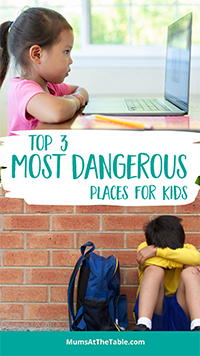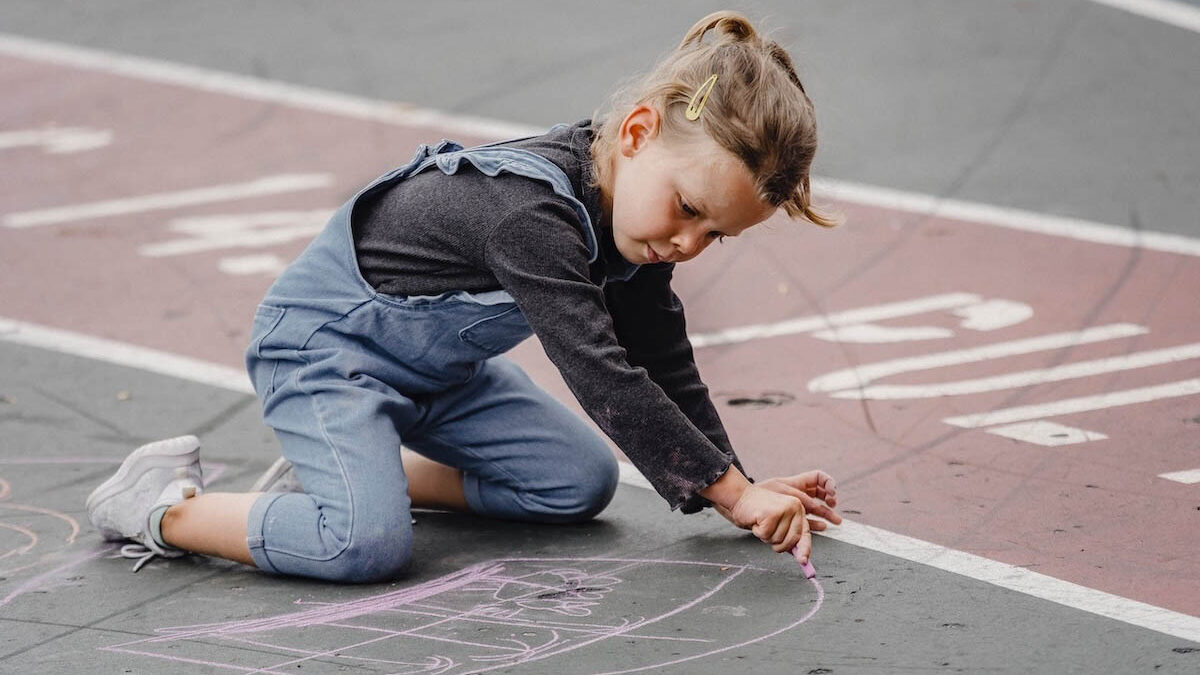Forget stranger danger. There are three other more dangerous places our children could be—and they don’t necessarily involve strangers.
Safety is very important in a child’s life. We’ve all seen the effects of childhood trauma and there’s a chance you’ve experienced it too. The statistics are alarming and you don’t want your child to be part of it.
Yet, we don’t want our children growing up in fear, spooked by every unknown corner. How do we have difficult conversations with our kids about “stranger danger”, while not terrifying them? How do we give them a healthy sense of caution while still ensuring they enjoy their childhood?
Here are three of the most dangerous places your child will most likely be and how to minimise the risks. We’ve also created some easy conversation starters to have with your child, to help keep them cautious and aware of their surroundings.
First, there isn’t a one-size-fits-all safety rule
You’d like to think all you have to do is to teach your child about stranger danger and you’ll keep them safe. (Think: Don’t accept lollies from strangers.) Sadly, in our world today, there isn’t a one-size-fits-all safety rule that will protect them.
There are multiple, complex, dark forces at work. They will destroy your child’s innocence, identity and mental health, and they are coming from almost every direction.
Which directions? Here are are our top three.
The 3 most dangerous situations in your child’s life
If you grew up in the ’90s or earlier, you would know that the risks for potential danger were far less for a child than they are now. While some of these situations would be familiar to us when we were kids, lessons learned over the years have taught us they can be far from safe for young people.
Stranger danger is real, but most of the time, it’s not an actual abduction on the side of the road. Let’s start with one that’s often overlooked:
1. Traditional “safe places”
Places we would usually consider safe are the best spots for dangerous people to hide. Religious institutions, churches, schools and educational settings, medical settings, and even family and friends’ homes, are not necessarily safe places.
Never, ever trust someone is safe enough for your child unless you are 110 per cent certain. Don’t assume because they are family they are safe. It’s simply not true. Statistics show most of the abuse children receive is from known adults and known children. Family members are usually the first people a child will receive abuse from, whether it’s an older adult relative or an older child relative.
The same goes for friends. The statistics of child-on-child abuse are now terrifyingly high, with many of the abusers being in the same grade or just a little older. Consider whether you should let your child go on playdates unsupervised or have sleepovers. Don’t assume that the other child’s parents share your values or will supervise the children.
Church, educational and medical settings are not always safe places as well. Sadly, many “church people”, teachers and even doctors don’t equate to “safe” people any more than your average stranger.
How to protect your children:
- Never assume people are “safe” unless you know 110 per cent that they are.
- Never leave your child in places with people you don’t truly know the character of.
- Build trust with your child. If they don’t trust you enough to talk to you about their trauma, they most likely won’t be telling police officers either.
- Talk to your child about trust and boundaries, and what is acceptable behaviour and what isn’t.
How to talk to your child: (appropriate for a seven-year-old)
“Not everyone who looks friendly and safe actually is. Sometimes people will try to be your friend so they can hurt you. Sometimes people will trick you into hanging out, so they can ask you to do inappropriate things together.
“If someone wants to be alone with you, asks you to meet them somewhere alone or asks you to do things you know are not right, you need to very loudly shout, ‘No! I don’t like it. Stop and get away from me.’
“I want you to run away from that person immediately. If they won’t let you go, you have my full permission to scream and hurt them so that they will let you go.”
2. Being alone
If your child travels alone on public transport, walks or rides to school independently, or is at home by themselves, be aware your child is extremely vulnerable. It doesn’t necessarily mean they will be sexually abused or abducted, but they can be in a threatening situation.
Sitting alone waiting for the bus or walking alone every day on a regular school route can make them targets. In a way, they are defenceless, prone to being pinpointed and picked out by bullies or other tricky people.
How to protect your children:
- If you allow your child to be alone, you need access to their location and they need access to help.
- Limit the amount of time they are alone as much as possible.
How to talk to your child: (appropriate for a seven-year-old)
“When you are not with a parent or safe adult, some people may try to trick you or hurt you because they see that no-one is around to get them into trouble. If you ever feel uncomfortable, think you are being followed or you see a group of kids coming towards you who you don’t know, you need to get away to somewhere safe and call for help. Not everyone who looks friendly is friendly.”
3. Technology
By far the most dangerous place your child will ever find themselves is with technology. The internet, video games, computer games, social media and chat rooms are the ultimate childhood destroyers.
Parents, please understand this:
Your child doesn’t need to look for porn, porn is looking for them.
The average age for a child to witness pornography is now as young as under eight. Pornographic material, whether in the form of photos, videos, cartoons or advertising, is splattered everywhere across the internet.
Read: What to do if your child has seen porn
Aside from the easy access to porn, your child can also be stalked by pedophiles online. Social media and chat rooms are lurking places for child abusers. They use these platforms to seek out children, befriend them, build trust and groom them.
Sexual abuse doesn’t just involve inappropriate touching. It also involves asking for nude pictures, asking questions about sexuality or giving out sexual information. Don’t think because your child is not being physically abused that they are not in danger of sexual abuse.
Then there are the social media bullies who continually feed their heads with status expectations, self-harm and suicidal suggestions, and hate speech. Of course, there are also people they know who may bully them online.
How to protect your children:
- Talk to your kids. Have open and honest conversations that are age-appropriate with your children. Teach and model to them what good and safe behaviour looks like. Teach them that there are bad people out there who want to ruin their lives and that these people can often be found on the internet.
- Supervise your child online. Don’t ever let your child have free access to the internet. They might not have bad intentions. But there are others who do.
- Go into the settings on every device (phone, computer, laptop, iPad etc.) and customise the settings to block all adult content, apps, books, music and websites.
- Don’t let your child have a social media account. This might sound harsh and mean, but it’s easy to access explicit material on platforms such as Instagram, TikTok and Facebook. If they want to chat with a friend, they can do it on your phone or have them over to your house for a play date. They don’t need to use social media.
How to talk to your child: (appropriate for a six-year-old)
“You know how there are bad people out there who want to hurt other people? They like to hide on the internet and trick people into talking with them and hanging out online. Many pretend to be a different person and fake their name and their age. They appear to be really friendly and kind. But these people are dangerous. If you see something bad online, don’t be afraid to tell me, you won’t be in trouble.”
You are their guardian
As a parent, you are your child’s guardian: Someone who guards and protects. Young children do not have the capacity to protect themselves, and even older children don’t understand the dangers that surround them. You need to guide and teach children, but you also need to protect them.
You can never be too cautious. Children’s safety should be the most important thing to you as a parent. Don’t believe or trust anyone unless you are totally sure. Even then, allow room for doubt. “Safe adults” are not always safe.
It’s a good idea to help your child know what is right and wrong at a very early age. Teach them about consent, how to say no, how to stand up for themselves, how to speak up for others and how to go against a group’s opinion if it’s wrong. These can be life-saving skills for them.
Teach them who is a trusted adult they can turn to for help, and also teach them that just because someone is a “grown up” doesn’t mean they are safe. Give them real possible scenarios and examples so they know abuse can happen anywhere. As a parent, you might feel like you’re filling their head with scary ideas, but in actuality, you’re protecting them from real-life devastating trauma.
You can never undo trauma once it has happened. You can never remove it from their mind, memory or body. In order to keep your child safe, you need to teach them about the dangers, you need to help them use their voice and you need to take action to protect them.

How helpful was this article?
Click on a star to rate it!
5 / 5. 3
Be the first to rate this post!
Adriana Wales
Related posts
Subscribe
Receive personalised articles from experts and wellness inspiration weekly!

